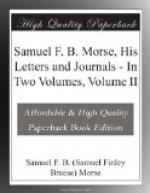And now at last the supreme moment had arrived. The line from Washington to Baltimore was completed, and on the 24th day of May, 1844, the company invited by the inventor assembled in the chamber of the United States Supreme Court to witness his triumph. True to his promise to Miss Annie Ellsworth, he had asked her to indite the first public message which should be flashed over the completed line, and she, in consultation with her good mother, chose the now historic words from the 23d verse of the 23d chapter of Numbers—“What hath God wrought!” The whole verse reads: “Surely there is no enchantment against Jacob, neither is there any divination, against Israel: according to this time it shall be said of Jacob and of Israel, What hath God wrought!” To Morse, with his strong religious bent and his belief that he was but a chosen vessel, every word in this verse seemed singularly appropriate. Calmly he seated himself at the instrument and ticked off the inspired words in the dots and dashes of the Morse alphabet. Alfred Vail, at the other end of the line in Baltimore, received the message without an error, and immediately flashed it back again, and the Electro-Magnetic Telegraph was no longer the wild dream of a visionary, but an accomplished fact.
Mr. Prime’s comments, after describing this historic occasion, are so excellent that I shall give them in full:—
“Again the triumph of the inventor was sublime. His confidence had been so unshaken that the surprise of his friends in the result was not shared by him. He knew what the instrument would do, and the fact accomplished was but the confirmation to others of what to him was a certainty on the packet-ship Sully in 1832. But the result was not the less gratifying and sufficient. Had his labors ceased at that moment, he would have cheerfully exclaimed in the words of Simeon: ’Lord, now lettest thou thy servant depart in peace, for mine eyes have seen thy salvation.’
[Illustration: FIRST FORM OF KEY]
[Illustration: IMPROVED FORM OF KEY]
[Illustration: EARLY RELAY The two keys and the relay are in the National Museum, Washington]
[Illustration: FIRST WASHINGTON-BALTIMORE INSTRUMENT The Washington-Baltimore instrument is owned by Cornell University]
“The congratulations of his friends followed. He received them with modesty, in perfect harmony with the simplicity of his character. Neither then nor at any subsequent period of his life did his language or manner indicate exultation. He believed himself an instrument employed by Heaven to achieve a great result, and, having accomplished it, he claimed simply to be the original and only instrument by which that result had been reached. With the same steadiness of purpose, tenacity and perseverance, with which he had pursued the idea by which he was inspired in 1832, he adhered to his claim to the paternity of that idea, and to the merit of bringing it to a successful




